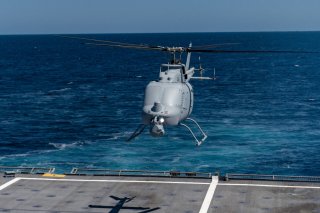Will the Fire Scout Drone Become the Navy’s Unmanned Minehunter?
The U.S. Navy is considering increasing the mission scope for its MQ-8C Fire Scout drone.
The U.S. Navy is considering increasing the mission scope for its MQ-8C Fire Scout drone by integrating a new radar and making use of a cutting-edge suite of countermine detection and neutralization systems.
There are many deep water threats alongside littoral and coastal mine areas wherein forward-positioned drones could help protect surface ships. Countermine technology on the Fire Scout would also be of particular significance in support of amphibious attacks, as forces attacking from ship-to-shore would need mine threats to be identified and neutralized prior to their arrival along the coast or beachhead.
The “C” variant of the Fire Scout operates with an upgraded version of a special coastal mine-hunting technology called Coastal Battlefield Reconnaissance and Analysis, or COBRA. Operational now for many years on the MQ-8B, COBRA’s main function is mine-detection and submarine hunting. The “B” model incorporates COBRA block 1, however, the “C” model of the Fire Scout will integrate the more advanced COBRA block 2 variant. The Navy’s ongoing effort to integrate the more effective LINK 16 datalink could allow the Fire Scout to move from a single point-to-point transmission wherein it sends video feeds and data back to a host ship to being able to operate as a key combat “node” within a larger meshed network of platforms.
Referring to this technological capacity earlier this year at the Surface Navy Association Symposium, Capt. Eric Soderberg, MQ-8 Fire Scout program manager, said that the Fire Scout “will be able to share its targeting data with the controlling ship and also disperse it more broadly. COBRA block 2 is based upon a LIDAR system, which puts laser energy into the water and measures the returns to determine whether they have a mine or not.”
Adding the Fire Scout would also closely align with the Navy’s current expansion of its fleet of Expeditionary Sea Bases (ESBs), key platforms intended to operate as maritime “sea bases” during operations. Navy ESBs are being upgraded and added to the fleet quickly, likely due to the crucial role they might be expected to play in theaters such as the Pacific, where vast oceans and waterways would make it difficult for land-based operations to function as an integrated unit or operate within reach of enemy targets. An ESB, however, could dispatch special operations missions with small boats, launch helicopters, and function as a critical staging area for maritime combat operations.
Kris Osborn is the defense editor for the National Interest. Osborn previously served at the Pentagon as a Highly Qualified Expert with the Office of the Assistant Secretary of the Army—Acquisition, Logistics & Technology. Osborn has also worked as an anchor and on-air military specialist at national TV networks. He has appeared as a guest military expert on Fox News, MSNBC, The Military Channel, and The History Channel. He also has a Masters Degree in Comparative Literature from Columbia University.
Image: DVIDS.

